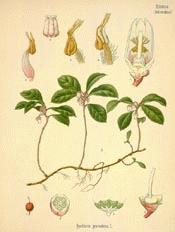
Botanical.com Home Page

|
Eastern Teaberry
(Gaultheria procumbens LINN.)
Click on graphic for larger image
|
Wintergreen
Botanical: Gaultheria procumbens (LINN.)
Family: N.O. Ericaceae
---Synonyms---Teaberry. Boxberry. Mountain Tea. Checkerberry. Thé du Canada. Aromatic Wintergreen. Partridge Berry. Deerberry.
---Part Used---Leaves.
---Habitat---Northern United States from Georgia to Newfoundland; Canada.
---Description---A small indigenous shrubby, creeping, evergreen plant, growing about 5 to 6 inches high under trees and shrubs, particularly under evergreens such as Kalmias and Rhododendrons. It is found in large patches on sandy and barren plains, also on mountainous tracts. The stiff branches bear at their summit tufts of leaves which are petiolate, oval, shiny, coriaceous, the upper side bright green, paler underneath. The drooping white flowers are produced singly from the base of the leaves in June and July, followed by fleshy, bright red berries (with a sweetish taste and peculiar flavour), formed by the enlargement of the calyx. The leaves were formerly official in the United States Pharmacopoeia, but now only the oil obtained from them is official, though in some parts the whole plant is used. The odour is peculiar and aromatic, and the taste of the whole plant astringent, the leaves being particularly so.
---Constituents---The volatile oil obtained by distillation and to which all the medicinal qualities are due, contains 99 per cent Methyl Salicylate: other properties are 0.3 of a hydrocarbon, Gaultherilene, and an aldehyde or ketone, a secondary alcohol and an ester. To the alcohol and ester are due the characteristic odour of the oil. The oil does not occur crudely in the plant, but as a nonodorous glucoside, and before distillation, the leaves have to be steeped for twelve to twenty-four hours for the oil to develop by fermentation - a reaction between water and a neutral principle: Gaultherin.
[Top]
---Medicinal Action and Uses---Tonic, stimulant, astringent, aromatic. Useful as a diuretic and emmenagogue and for chronic mucous discharges. Is said to be a good galactogogue. The oil of Gaultheria is its most important product. It has all the properties of the salicylates and therefore is most beneficial in acute rheumatism, but must be given internally in capsules, owing to its pungency, death from inflammation of the stomach having been known to result from frequent and large doses of it. It is readily absorbed by the skin, but is liable to give rise to an eruption, so it is advisable to use for external application the synthetic oil of Wintergreen, Methyl Salicylate, or oil from the bark of Betula lenta, which is almost identical with oil of Gaultheria. In this form, it is a very valuable external application for rheumatic affections in all chronic forms of joint and muscular troubles, lumbago, sciatica, etc. The leaves have found use as a substitute for tea and as a flavouring for genuine tea. The berries form a winter food for animals, partridges, deer, etc. They have been used, steeped in brandy, to produce a bitter tonic taken in small quantities. The oil is a flavouring agent for tooth powders, liquid dentifrices, pastes, etc., especially if combined with menthol and eucalyptus.
---Dosage---Capsules of oil of Gaultheris, 10 minims in each, 1, three times daily.
[Top]
---Other Species---
Gaultheria hispidula, or Cancer Wintergreen, supposed to remove the cancerous taint from the system. Is also used for scrofula and prolapsus of the womb.
G. Shallon is the Sallol of North-west America, whose edible fruit deserves to be more widely known and cultivated.
Pyrola rotundifolia, known as False Wintergreen or British Wintergreen, was formerly considered a vulnerary.
With Chimophila umbellata, the Bitter Wintergreen, Rheumatism Weed or Pipsissewa, C. maculata, the Spotted Wintergreen was used internally by North American Indians for rheumatism and scrofula. For its diuretic action it is occasionally prescribed, in fluid extract, for cystitis and considered useful in disordered digestion.
Trientalis Europaea, the Chickweed Wintergreen, a British plant, was formerly esteemed in ointment as a wound salve, and an infusion taken internally for blood poisoning or eczema. The root is emetic.
See PYROLA.
Common Name Index
A MODERN HERBAL Home Page
Bear in mind "A Modern Herbal" was written with the conventional wisdom of the early 1900's. This should be taken into account as some of the information may now be considered inaccurate, or not in accordance with modern medicine.
© Copyright Protected 1995-2025 Botanical.com
|

